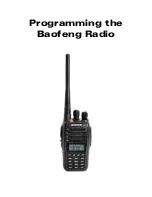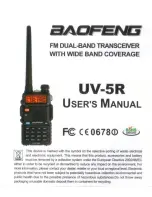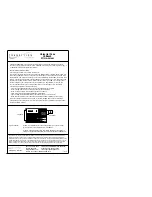
70-440 User manual
Page.
3
Congratulations. 70-440BP is an advanced Professional Radio. Its rugged design allows it to be your
reliable partner even during hard working days. Its LCD as well as user friendly controls make the 70-
440BP easy to use.
To extend the flexibility of the radio, a “
VOX”
(Voice Operated Transmit) function has been added which
allows switching the transmission just by talking in full hands free condition (with optional headset).
Transceiver’s specifications provided in 70-440BP are compliant with EIA/TIA 603 and ETS 300 086, The
70-440BP top level design and resistance are compliant with IEC529 level IP54 and MIL STD 810 C,D,E.
Midland Radio is committed to continuous quality improvements, for this reason specifications may vary
without prior notice.
Warning notes
Every effort has been made to ensure that the information in this document is complete, accurate, and up-
to-date. Midland Radio assumes no responsibility for the results of errors beyond its control. The
manufacturer of this equipment also cannot guarantee that changes in the equipment made by non
authorized people will not affect the applicability of the information in it.
FCC Licensing Information
This Midland model 70-440BP radio operates on frequencies which require a license from the Federal
Communications Commission (FCC) for business, personal, and recreational use.
For questions concerning licensing, contact the FCC at
1-888-CALL-FCC
(1-888-225-5322), or go to
http://www.fcc.gov
.
Safety
Your 70-440BP handheld transceiver has been carefully designed to give you years of safe, reliable
performance. As with all electrical equipment, however, there are a few basic precautions you should take
to avoid hurting yourself or damaging the radio:
•
Read the instructions in this handbook carefully. Be sure to save it for future reference.
•
Read and follow all warning and instruction labels on the radio itself.
•
Do not carry the transceiver by the antenna
. This may damage the antenna or antenna terminal.
Grasp it by its base (not the tip!) when you need to place or remove it.
•
Do not keep the radio with the antenna very close
to, or touching exposed parts of the body, while
transmitting. The radio will perform best if the microphone is 5-10 cm away from the mouth and the
radio is vertical.
•
Be sure the “PTT” key is not pressed when you do not need to transmit.
•
Do not operate the radio near unshielded electrical blasting caps or in an explosive atmosphere.
•
Do not transmit without the antenna fitted on the radio
. Though it is provided with a protection, it
may damage the TX output final stage.




































